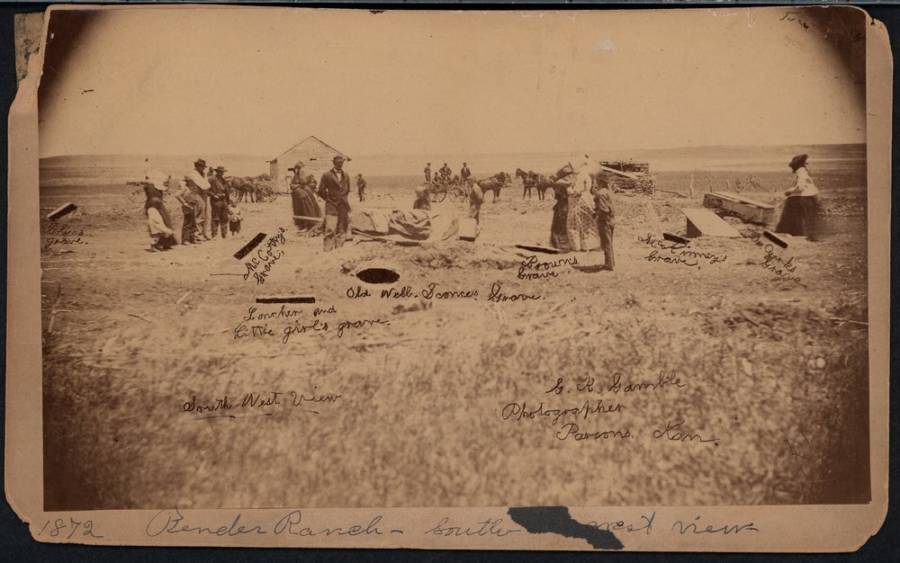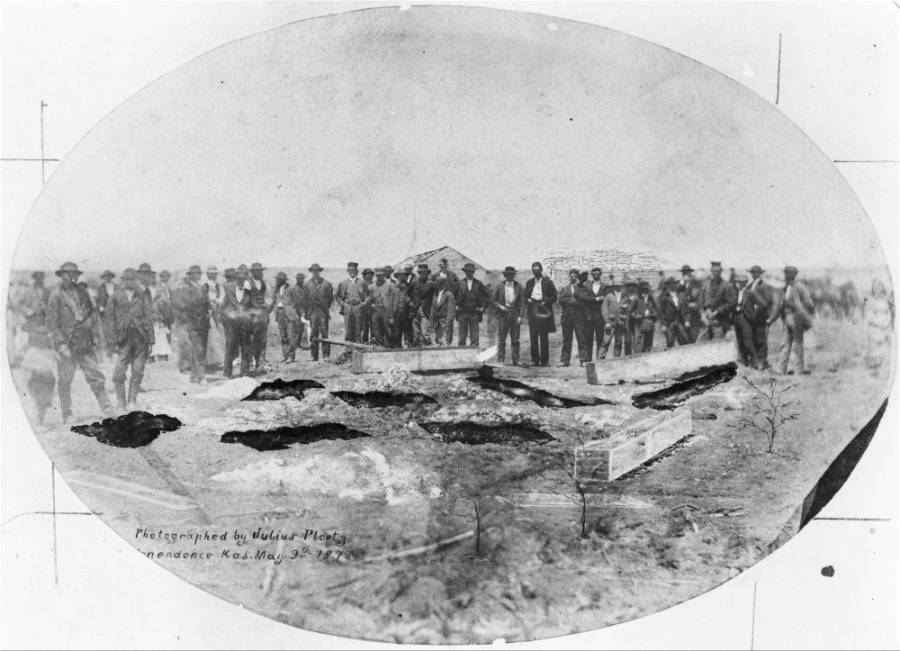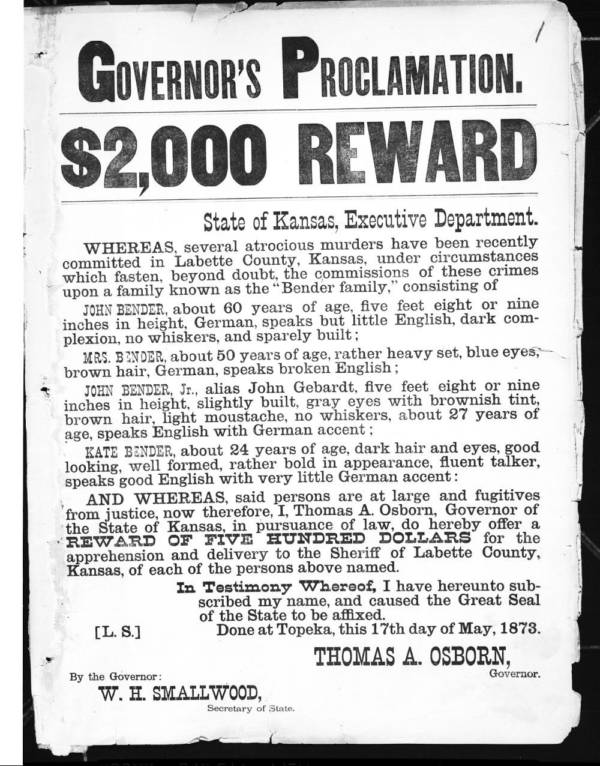The Bender family ran a small inn for travelers along the Osage Mission Trail in Kansas, but they suddenly abandoned their homestead in 1873 — then the bodies of people who had gone missing turned up buried on their property.

Public DomainPortraits of the Bender family members, John, Elvira, John Jr., and Kate Bender.
In 1873, at least 11 bodies were found on the property of the Bender Inn, a small store and resting place in Labette County, Kansas, for travelers on the Osage Mission Trail that was run by the Bender family. The murderous homesteaders had vanished, and despite a nationwide manhunt, nobody could find them. The story of the Bloody Benders soon captivated America.
Investigators determined that the Benders had targeted the travelers to rob them. They hid behind a curtain in their one-room cabin, slit their guests’ throats as they dined, then dropped them into the cellar through a trap door to bleed out. After this grisly news broke, the Bender Inn was torn apart by curious onlookers hoping to bring home a macabre souvenir, destroying any other evidence that may have been hidden inside.
John Bender; his wife, Elvira; a man presumed to be their son, John Jr.; and their daughter, Kate Bender, were never seen again. Over the next two decades, several men and women accused of being members of the family were arrested, but nothing ever came of the charges.
Even today, more than 150 years after these gruesome crimes occurred, the tale of the Bloody Benders stands as one of the most haunting mysteries of the American West.
Labette County, Kansas In The Late 19th Century
Before Kansas became the 34th state in 1861, the region was primarily inhabited by Indigenous tribes. Around the 1840s, settlers, traders, and merchants began establishing trade posts in the area and integrating into the local communities, often through marriage with Native Americans.
Among these settlers was the French-Canadian fur trapper Pierre LaBette, for whom Labette County would later be named.

Kansas Historical SocietyThe Bender family’s home in Labette County, Kansas.
Labette County was officially established on Feb. 26, 1867, and in the years following the Civil War, the U.S. government actively encouraged more westward expansion. During this post-war period, the population of Labette County grew rapidly. According to a report from the Kansas State Board of Agriculture, between 1870 and 1878, the population rose from 9,973 residents to 17,190.
But not everyone who moved to Labette County during this time had good intentions, and there were tensions between settlers and the Indigenous tribes who had already inhabited the land. During this turbulent time of expansion, the Bender family established a presence — and carried out their gruesome killings.
The Bender Family’s Odd Habits Hint At Something Darker

Kansas Historical SocietyAn advertisement referring to Katie (Kate) Bender as a healer.
There were some early indications that the Benders were a little strange. The community they settled in was founded by a group of spiritualists who believed in some rather unorthodox things. For instance, spiritualism taught that the spirits of the dead continue to live on after death — and spiritualists often practiced séances to contact these ghosts.
Kate Bender, who was probably John Bender’s daughter (whether or not the Benders were actually blood relatives is disputed), quickly gained a reputation as a psychic and healer who could talk to the dead. Even in a community of spiritualists, her sermons on the value of free love were considered a little odd. John, meanwhile, had a tendency to laugh aimlessly, which led many to think he might be mentally ill.

Kansas Historical SocietyThe Bender homestead was the site of at least 11 gruesome murders.
Elvira Bender (sometimes referred to as Almira), in particular, was so unfriendly that other members of the local community reportedly referred to her as a “She-Devil.”
Kate Bender was by far the most social member of the family, which made her the perfect face for their business. The Bender Inn was a modest, one-room cabin divided into two sections by a canvas wagon cover. One half functioned as a general store and dining space for travelers, while the other served as the family’s living quarters. They also maintained a vegetable garden and apple orchard on their homestead.
The Bender Inn’s location along the Osage Mission Trail meant it was strategically positioned to attract travelers — and also the perfect place for the Bloody Benders to carry out their deadly scheme.
Inside The Bloody Benders’ Murderous Plot
The Benders’ modus operandi was particularly gruesome. They would invite travelers to dine with them, seating guests at a “place of honor” — directly over a trap door.

Kansas Historical SocietyA pit on the Bender property that held their victims’ bodies.
Kate Bender would distract them with conversation while one of the men hid behind the canvas curtain. Then, as the Weekly Kansas Chief reported on May 22, 1873:
“In this position it was an easy thing for the male villain in the front apartment to strike the form clearly lined and resting against the white cloth, and when the blows of the sledge and hammer had knocked the victim with a crushed and broken skull, senseless and helpless to the floor, for the female fiends in the back room to cut their throat.”
The Bloody Benders then dropped the bodies into the cellar through the trap door, where they could bleed out without leaving a mess in the house. There, the family stripped their victims of any valuables and buried them in the orchard behind the house.
This scheme continued for about two years — but then the Bloody Benders killed the wrong person.
How The Bloody Benders’ Crime Spree Came To An End
As travelers began disappearing along the Osage Mission Trail in the early 1870s, people grew suspicious. There had been rumors circulating about the Benders, and some visitors to their inn reported feeling uncomfortable, as if they were in danger. One man, William Pickering, refused to sit in the seat offered to him at the dining table because he spotted blood on the canvas — and was subsequently threatened by Kate Bender with a knife, prompting him to quickly flee.

Kansas Historical SocietySeven graves found on the Bloody Benders’ property.
Similarly, a Catholic priest, Father Paul Ponziglione, claimed to have seen one of the Bender men concealing a large hammer, which made him uneasy and led him to leave under the pretense of tending to his horse.
Then, after a man named George Longcor and his 18-month-old daughter vanished in the area in 1872, their friend Dr. William York went looking for them the following spring. When Dr. York disappeared as well, his brother, Colonel Alexander York, traveled to the Bender Inn to inquire about him.
The Benders told Colonel York that his brother had probably been killed by the Native Americans in the area. However, York heard stories about the Benders that roused his suspicion during his investigation. At a township meeting in May 1873, residents agreed to obtain warrants to search every homestead in the area, including the Bender Inn.
Before they could question the Benders again, however, the family abandoned their home. A search party investigated — and uncovered the Bloody Benders’ haunting crimes.
After digging around the property, investigators found at least 11 bodies, including those of Longcor, his young daughter, and Dr. York. A manhunt was immediately launched for the murderers.

Kansas Historical SocietyThe reward offered for the capture of the Bloody Benders.
However, the Bender family had seemingly disappeared. Some people thought they might have been killed by vigilantes, and others believed they had fled the country. Despite numerous reported sightings over the years, no one ever discovered where they had gone.
The Bloody Benders quickly passed into legend as America’s first serial killer family, and their story remains a ghastly part of Kansas folklore to this day.
After learning about the Bloody Benders, check out the story of Edmund Kemper, the 6’9″ serial killer who murdered his grandparents and eight women. Then, read about Carl Panzram, the most twisted serial killer you’ve never heard of.





